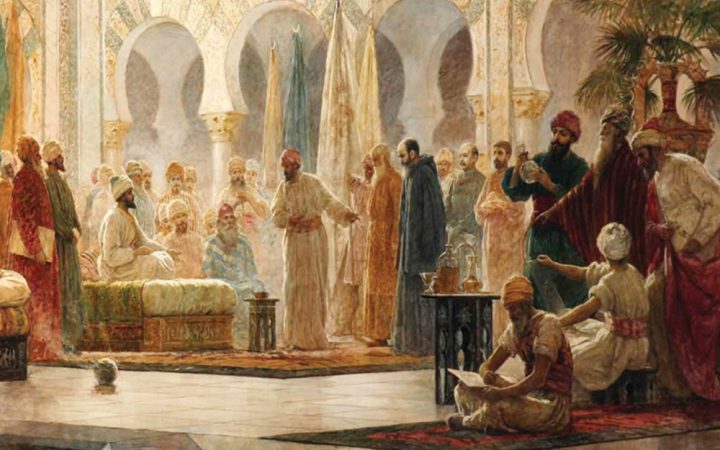I’ve recently written an article about astronomy. I was shocked to find out that most of the early scientific discoveries in this field were made by eastern scientists in Baghdad. Then I learned it was not just astronomy that was shaped immensely by Abbasid scientists, but also mathematics, physics, chemistry, and medicine. “0” and the numbers we use today were developed then, as well as algebra and many more innovations. After this, I became very interested and researched the whole history of Islam and its Golden Age.
In this introductory article, we will provide insights into the history of Islam. Since this is such a broad subject, we won’t delve into each topic in depth, but will instead provide an overview of the context and timeline of Islam.
Though I am particularly interested in specializing in the flourishing of knowledge during the Islamic Golden Age—especially in the Abbasid and Al-Andalus eras—encompassing not only science, mathematics and astronomy but also art, culture, literature, philosophy, law, and many other disciplines whose enduring contributions continue to shape our present.
The Messenger 571–632
On 20 April 571, a man in Mecca (today’s Saudi Arabia) was born who was to become the last messenger of God.
Prophet Muhammad was known for his good morals and trustworthiness even before his prophecy, for which he received the nickname “Al-Amin” (the trustworthy). He was liked by the people of Mecca and was often chosen as a judge in various disputes.
At the age of 40, in 610, he received his duty as the final messenger of God and served until his death in 632. He received the verses of the Qur’an through revelation.
When he announced his prophecy and called people to Islam, some followed him, some ignored him, but most considered him a traitor and a liar. Suddenly he was no longer liked by the people of Mecca.
Not just disliked, but outright hated: the Jews of the region expected a prophet to come, but felt disappointed he was not from their bloodline, so they denied his prophethood despite recognizing the signs. Most of the people of Mecca, including Muhammad’s wealthy uncles, held polytheistic and idolatrous beliefs (belief in multiple gods and worship of idols/statues). They rejected the message Muhammad conveyed and tried to suppress him.
Eventually, Muhammad faced many obstacles—constraints, torture, and persecution—attempts to make him give up his duty as messenger of God.
In 622 CE, Prophet Muhammad, along with his followers, migrated to Medina (then called Yathrib), which would later become the central hub of Islam and the capital of the first Islamic state. This event is called the Hijra and it played a spectacular role in the growth of Islam.
He received revelations both in Mecca and Medina, which were later compiled into the Qur’an.
In 632 CE, at the age of 62 (some sources say 63), Prophet Muhammad passed away.
Rashidun 632–661
This was the era of the first four Caliphs (successors) after the death of the Prophet: Abu Bakr, Umar, Uthman, and Ali.
In this 30-year period, much progress was made. The first Islamic state was firmly established with institutions, taxes, and bureaucracy. Great expeditions and conquests expanded Islamic borders to North Africa in the west, Persia in the east, and Anatolia in the north after the severe defeat of the Byzantine army.
Despite the rise of Islam, three of the four Caliphs were assassinated (Umar, Uthman, and Ali).
This era also saw the emergence of Islam’s two main sects: Sunni and Shia.
Supporters of Ali (the 4th Caliph) shaped the Shia branch, based on the belief that “Ali and his descendants are the only legitimate rulers because the Prophet was related to him (Ali married the Prophet’s daughter) and appointed him as his successor.”
Sunnis did not recognize such an appointment. Today, Shia Muslims make up about 10–15% of the global Muslim population, while Sunnis form 85–90%.
Umayyads 661–750
In this age, the Umayyads became the ruling authority of the Islamic world. The capital moved to Damascus, and expansion continued.
In 711, the Iberian Peninsula (today’s Spain and Portugal) was conquered under the command of General Tariq ibn Ziyad and the governor of North Africa Musa ibn Nusayr. This opened the gates of Europe to Islam and shaped a civilization, Al-Andalus, that lasted for more than seven centuries and made enormous contributions in science, culture, and literature—later inspiring the Renaissance. Meanwhile, in the east, Umayyad troops conquered much of Central Asia.
Despite their power, the Umayyads had flaws. The most painful was the tragedy of Karbala (680), where Ali’s son and the Prophet Muhammad’s grandson, Husayn, was killed by the forces of Caliph Yazid ibn Muʿawiya.
The Umayyads are also often remembered as strict rulers, more focused on expansion than justice. Some accounts accuse them of heavy taxation and forced conversions. General Qutayba ibn Muslim, for instance, is remembered as a brutal commander accused of massacring thousands. Caliph Yazid ibn Muʿawiya was also criticized for re-imposing taxes on non-Arab Muslims, a discriminatory policy that violated the Prophet’s teachings and Islamic values.
While not all accounts can be verified, I believe later rulers did a far better job of embodying Islam’s message—both in presenting its ideals and in applying them.
Abbasids 750–1250
This is my favorite part of Islamic history: the Golden Age.
In 750, the Abbasids replaced the Umayyads and moved the capital to Baghdad, which soon became a global symbol of prosperity. The Abbasids, descended from al-Abbas (the Prophet’s uncle), adopted a more moderate political approach than the Umayyads. Rather than focusing on conquest, they prioritized scholarship, science, and intellectual life, supporting both secular and religious studies.
Immense discoveries were made in mathematics, astronomy, medicine, architecture, chemistry, engineering, philosophy, poetry, and more. Al-Khwarizmi developed algebra and introduced the “0” and the numeral system we use today, while Ibn al-Haytham laid the foundations of optics and the camera. The term “algorithm” comes from Al-Khwarizmi’s name. The world’s first university, al-Qarawiyyin in Fez (859 CE), also flourished in this age.
The Golden Age peaked under Harun al-Rashid (786–809). However, by the late 9th century, Abbasid power declined as regional dynasties—especially Turkic ones—rose in influence.
In 945 CE, the Shi’a Buyids seized Baghdad, reducing the Abbasid caliph to a figurehead. In 1055 CE, the Sunni Seljuks took control, restoring Sunni dominance.
Seljuks 1055–1194
In 1055, Sultan Tughril entered Baghdad at the invitation of the caliph to remove the Buyids and restore Sunni authority. The Seljuks didn’t move their capital to Baghdad but controlled it from afar.
In 1071, the Seljuks achieved a great victory over the Byzantines at Manzikert, opening the gates of Anatolia to Turkish settlement. Anatolia eventually became the new homeland of the Seljuks.
Later, the Turkic Khwarazmian Empire replaced the collapsed Seljuk Empire.
Mongols 1206–1368
The Mongol Empire, though not Islamic, left a major impact on the Muslim world through destruction.
After conquering Central Asia and Persia, Hulagu Khan, grandson of Genghis Khan, invaded Baghdad in 1258. The city was devastated, the Abbasid caliph al-Mustaʿsim was executed, and the House of Wisdom—the world’s greatest center of knowledge—was destroyed. Some sources say the Tigris (the river in Baghdad) first ran red with blood, then black with ink from the drowned manuscripts.
Many historians argue that only a very small portion of Baghdad’s works survived. They suggest that, had such devastation not occurred, our civilization might have reached an entirely different stage of advancement.
The Mongols eventually fractured into regional dynasties, many of which later converted to Islam.
Ayyubids 1171–1260
This Sunni dynasty was founded in Egypt by Salah al-Din (Salahaddin). He ended the Shi’a Fatimid dynasty and expanded his power into Syria.
Among the greatest achievements of the Ayyubids was the reconquest of Jerusalem in 1187, nearly 90 years after its loss to the Crusaders in 1099.
Mamluks 1250–1517
The Mamluks, originally Turkic slave-soldiers, seized power in Egypt. In 1260, they famously defeated the Mongols at Ain Jalut—the first major Mongol defeat in open battle.
They then invited a surviving Abbasid prince to Cairo, re-establishing the Abbasid caliphate in symbolic form. The caliph had no real power, serving only as a religious figurehead.
Ottomans 1299–1922
Founded by Osman Ghazi in Anatolia, the Ottoman dynasty rose as the new Sunni authority.
In 1453, Mehmed II conquered Constantinople, earning the title Fatih Sultan Mehmed (Mehmed the Conqueror). This fulfilled a prophecy cherished in the Muslim world.
His grandson Selim I (Yavuz Sultan Selim) later tripled the empire’s size and, in 1517, conquered Egypt, transferring the caliphate to Ottoman hands. From Fatih to his son Suleiman the Magnificent, the Ottomans enjoyed their own Golden Age.
The Ottoman Empire lasted more than six centuries. In the early 20th century, it collapsed, replaced by the Republic of Turkey, which formally abolished the caliphate in 1924.
From the time of the Prophet Muhammad in the 7th century to the Ottoman era in the 20th century, Islamic history covers many centuries of change, growth, and influence. Each period left something behind—some were marked by conquests and politics, others by learning, culture, and art. Together, they shaped not only the Islamic world but also world history as a whole.
In the next articles, we’ll look more closely at the scientific and cultural achievements of the Islamic Golden Age—especially under the Abbasids and in Al-Andalus. This article was only meant as an introduction and overview.




